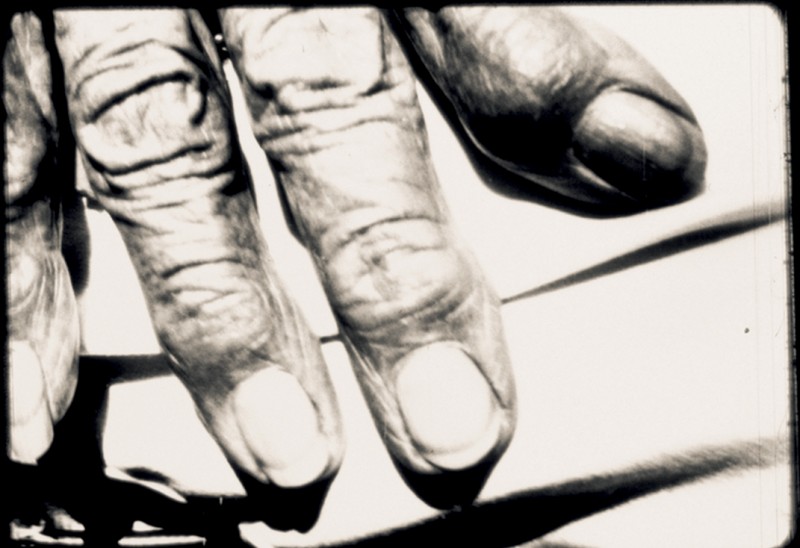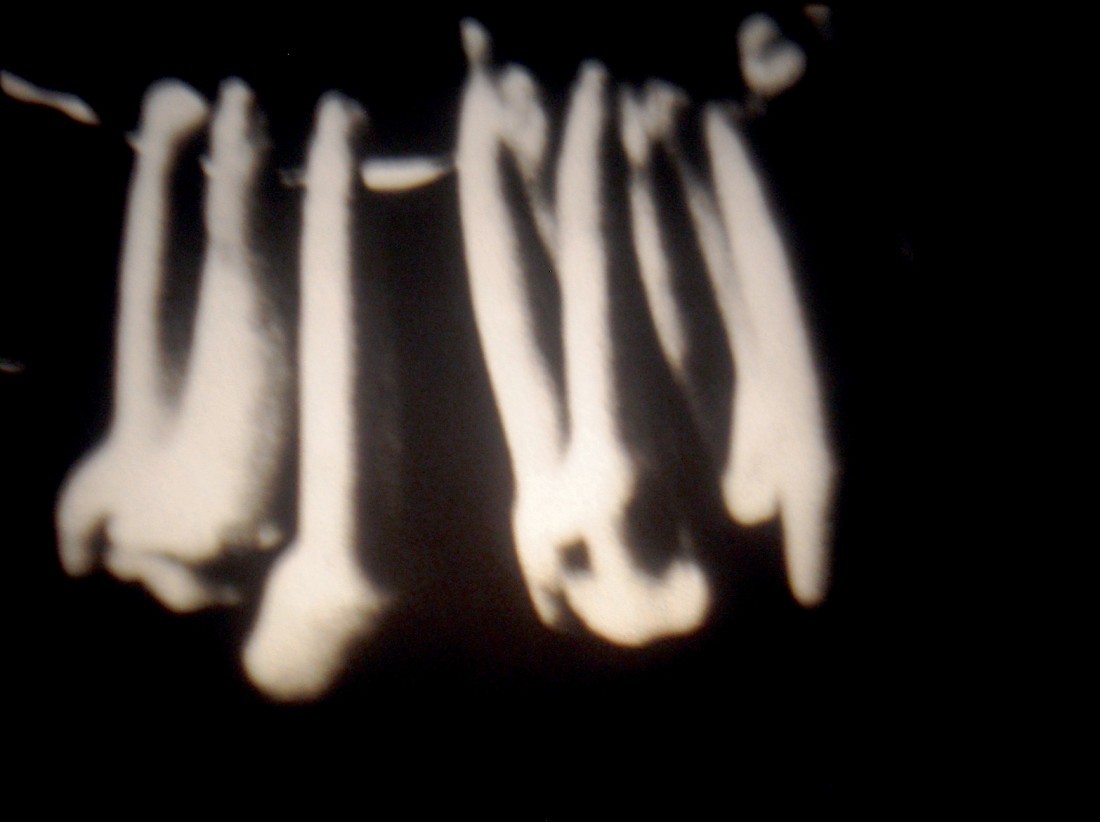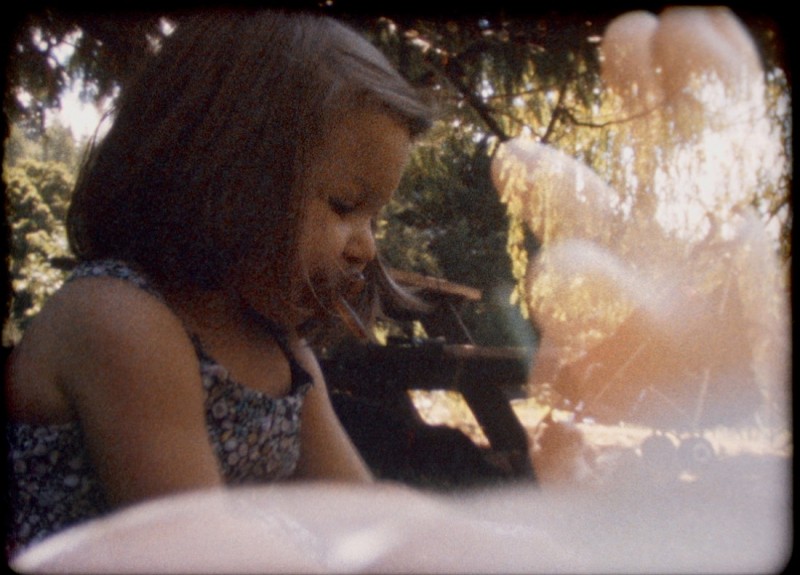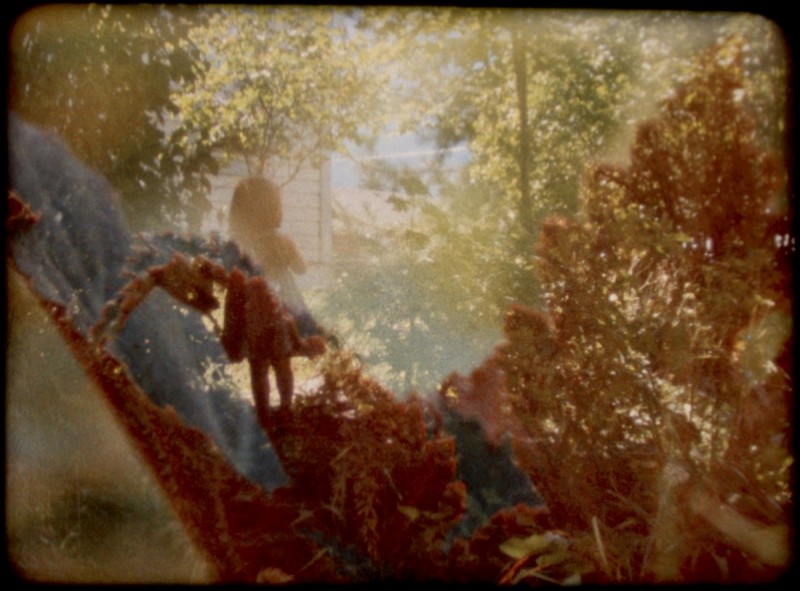The Hand Made’s Tale
An Interview with Lindsay McIntyre
Lindsay McIntyre’s films are familial and cultural meta-narratives; at the same time that they tell the story of her Inuk great-grandmother’s life, they also tell the story of their own making. Much of their power comes from their material presence. McIntyre makes her own emulsion, so that her films look as if they have come to us from another time. The scratching and degradation are utterly seductive; the mind wants to understand what the eye is seeing, and what we are seeing can be everything from an ulu, the Inuk cutting tool, to caribou teeth strung on a wire and held in the beautifully lived-in hands of a matrilineal family member. She can run her camera lens over the weighty surface of a massive steel vessel caught in the Arctic ice, or in her backyard garden where she records her daughter’s flickering, lyric presence. McIntyre has an instinctive sense of visual rhythm, and her films move at radically different speeds, sometimes so slow that were it not for the faint movement of grass in the foreground of a landscape, you would think you were looking at still images. At other times her footage flashes by so quickly that your recognition has to play a game of catch-up with your perception. The range of her filmography is impressive: documentaries about the history of the medium; narratives that repurpose found footage as fictional narratives; visual tone poems that combine her fascination with machinery and the northern landscape; film portraits of a young Inuk athlete and an aged Inuk woman; a home movie about her mother and daughter; a word-driven inquiry into a Manitoba Indian residential school that takes the form of a projection-mapping installation on the exterior of the Vancouver Art Gallery; an unpeopled remake of the famous gunfight scene from The Good, the Bad and the Ugly, where the characters are replaced by a wagon and a rusty cart in a junk pile; even a satiric instruction film about how to make experimental cinema. However different the films may be in subject matter, her signature sits on them all, a kind of visual fingerprint. As she says in the following interview, “There is always the mark of me as a maker in my works.”

Lindsay McIntyre, her silent life., 2012, part of the “Bloodline” series, 16 mm, 31 minutes, hand-processed, colour and black and white.
That touch is most evident in the “Bloodline” series, a set of five films she began in 2007 with what she would not leave behind and ended with her silent life. in 2012. The films relate the history of Kumaa’naaq, her Inuk great-grandmother who was brought south from Nunavut by Ray Ward, an RCMP constable who wanted her for his wife. It was the second time she had been removed from her community. As a young child (she was between six and eight years old), she was taken from Whale Cove by a missionary couple who said she was “too beautiful to live out her life with the savages.” She returned to the North when she was 18 and lived in Baker Lake for 20 years until she was “kidnapped” by Ward. Kumaa’naaq’s is an extraordinary and tragic story but McIntyre’s handmade films present it as a collection of compelling, unanswered questions. Everything in the films has some connection to her interrogating imagination. “I am telling our family stories, but I’m not trying to claim an ultimate truth about a specific thing,” she says. “I think it is more important to create space for different truths to exist.”
The following interview was conducted by phone to the Cineworks Studio in Vancouver on November 3, 2119.
BORDER CROSSINGS: I like foundational stories that relate how artists become artists, and yours has to do with finding a piece of film on the street in New York.

her silent life., 2012, part of the “Bloodline” series, 16 mm, 31 minutes, hand-processed, colour and black and white.
LINDSAY MCINTYRE: I was a visual artist before I started working in film and I didn’t come to the medium the way many filmmakers do, which is with the intent of trying to tell stories. I came to it more as a visual artist who wanted to work with the material in my hands. The very first piece of film that I came across was when I was playing a game with a friend of mine while living in New York in 1999. It was called the “Up and Down” game and the two of us would walk around the filthy streets of Brooklyn, the Bronx or Queens, wherever we were, and find things on the street and then take them home and make other things out of them. So the person who got on belly-button level and down always got the richest material because you could find things like fish heads, which you could then encase in a rubber mould. The upper levels would only get you unexciting things like paper and plastics. One of those days I was lucky enough to find a ratty little mess of 16 mm black and white film under a tree. I had never seen or touched film before. I didn’t really know what it was, but I could see the images on it (I think I figured out later that it was a guy talking about farming or something). So I brought it home and tried to do some things with it. It was a transparent material, and when I stuck some tape on it, I was able to lift up the image, which was in itself miraculous to me. And then, since that piece of tape was still somewhat sticky, I was able to stick it down onto another piece of film. Basically, in my mind, I had double-exposed the film. Combining these two images was so exciting that I wanted to do more and more and more of it. This was the early days of eBay and the Internet so I made myself an eBay account and ordered some film and bought a projector. I was going to get to do more of this emulsion-lifting thing, but it turns out that normal film won’t do what my found film did. That first piece of film had been sitting in the sun and the rain for so long that its physical properties had changed—it had probably been peed on, for all I know—but it didn’t perform like normal film stock would. When none of the new film I’d acquired would respond this way, I was disappointed and I spent a lot of time trying to figure out how I could make it happen, and in the process of trying to figure that out, I did almost two years of research. By this time, I was getting to know some experimental filmmakers in New York and other places, and I was talking to them about what I was trying to do, but nobody could tell me how to do it. It seemed that nobody knew. The unfortunate truth is that they did know about emulsion-lifting and exactly how to do it, but they were hoarding the technique and deliberately not telling me. Eventually I figured out on my own that you can do it with a household cleaner called Fantastik. You basically soak it in Fantastik for a few seconds and then you scrape off the emulsion with a razor blade. I was so put off by the idea that someone would claim ownership of the technique that I made a short film about it called How to Make a Phantastik Film (2003).

though she never spoke, this is where her voice would have been., 2008, part of the “Bloodline” series, 16 mm, 4 minutes, handprocessed, black and white.
I can’t help but think you were playing off Rosler’s Semiotics of the Kitchen (1975) in How to Make a Phantastik Film, as if you were doing your experimental film version of that style.
There may have been some of that. It was definitely meant to be satirical and to make fun of experimental filmmakers. I figured I could do that because I was one of them. The film was made for an audience of experimental film lovers for an Images Festival program called Minute Movies.
When you realized that there was a thing called “experimental film,” did you set out to learn about people like Stan Brakhage, Carolee Schneemann, Maya Deren, Jonas Mekas and Shirley Clarke? How systematic were you in inquiring into something that you had inadvertently discovered on the street?
It was incredibly exciting when I discovered that this kind of filmmaking actually existed in the world and it wasn’t just me doing what I was doing on my own. But it is interesting that I came to it from drawing and scratching on the film to seeing what I could do to change its physical properties and push up against boundaries, and there were a lot of physical boundaries to working on 16 mm celluloid. My world cracked open when I took a class called Recycled Images, taught by Louise Bourque at Parsons University at the New School. I discovered all these other people who were vitalizing the margins of film, and many of them—Brakhage, Schneemann and Clarke—have been a big part of my personal education. Most of that education isn’t stuff I learned in school; most of it came from a desire to seek out films that inspired me and that I was interested in learning about. It was often hard to get your hands on copies of these films, and even though that has changed with the Internet, it can still be difficult to see work on celluloid. Building film communities in the places I’ve lived has been, and still is, a big part of being able to see work that I’m interested in. In the beginning it was Double Negative in Montreal, but now it happens in a much wider network of artist-run film labs.
You have said before that you will always shoot on film because film is a tactile, physical thing. In a way, your filmmaking practice has allowed you to continue your material interests in actually making things with your hands. And, of course, the hand is an implement that appears repeatedly in your films. You’re a very hands-on filmmaker.
I am. I think that film is my material practice in the way that paint might be for a painter or beadwork might have been for my grandmother. It’s the way that I need to work through things. It comes from the fact that my first medium and first love is actually drawing. It is so important for me to have tools in my hands and to be actually manipulating those things, physically. I’m hand-processing film, I’m sometimes making the emulsion myself and I’m editing the film on a Steenbeck, physically cutting it. So in all respects it is always in my hands. I’m not a careful filmmaker; I’m not one to wear white gloves and be careful and delicate with negatives. There is always the mark of me as a maker in my works. Sometimes that literally means my fingerprints are in and on the work, but that mark is also there in the choices I make in editing and in filming. And you’re right, hands do show up in the work; in her silent life. (2012) they are a visual theme throughout the piece. Hands are the tools of tools. In my family, they are the way that I connect with my whole matrilineal history because the hands of my mother, my grandmother and my great-grandmother are all the same.

In The Backyarden, 2015, 16 mm colour reversal, 5 minutes, in-camera, sound, colour.
Do we have a romance about this idea of the degraded image that comes to us through a fragmented poetics?
I’m good with the fragmented poetics idea, but I’m not sure that I think about it in romantic terms. There is a sense of a revitalization, or maybe a renaissance, in celluloid filmmaking. I wonder if that comes from a sense of romanticism about the vintage look—the poor image. Celluloid was my first moving image medium and it was the first thing that I latched onto after drawing, so there may be an unwillingness and a stubbornness to let it go. It wouldn’t be the first time that someone called me stubborn. But it is so much a part of my practice that the qualities that come with it are part and parcel of the work itself. Sometimes when I’m working on commercial film stock, I feel like I’m cheating because somebody else made that film, someone else put in all the science and technology to make it beautiful. Commercial film is designed to be a window on the world and, for the most part, it gives us a perfect representation of our world. It is so incredibly good at what it does, and all I did was to take some pictures with it. So now I make my own emulsion. I think my essential defining core as an artist is that if there is a way to make something more difficult, then I am probably already doing it, or I am about to figure out how to do it. It’s important that my work is a labour. I do occasionally work digitally and I teach people how to make films in a digital environment, and there is a great deal of usefulness to the digital medium and form, but they are very, very different things. For me, it really comes down to its being a more material practice. Film is my material practice.

In The Backyarden, 2015, 16 mm colour reversal, 5 minutes, in-camera, sound, colour.
When you make your own emulsion, you put on a chemist’s coat, and I wonder if that makes the process less mysterious because you actually know how the medium is made.
Even though I’ve been shooting film consistently for 20 years, there is nothing about it that isn’t still magic. It is endlessly exciting to see what can arise from making an emulsion or trying a new process in the darkroom. For my practice, I need to understand the physical properties of film, and that takes me into realms I never thought I’d visit. I really wish I had taken chemistry in high school. In one sense, handmade emulsion is a very simple process, but it gets quite a bit more complicated when you think about using it for motion picture film. Some of that has to do with how the film gets coated onto a transparent plastic base material, some of it has to do with making an emulsion that is fast enough that it can be exposed in a camera at 24 frames per second and some of it is just crazy, mad science. When I first started making handmade emulsion, I was looking at notebooks and lab notes and scrawls from scientists and researchers who were working in the 1850s, but they weren’t measuring things the way that I would or could measure them now. In some cases they would say you need a pinch of this or a taste of this other thing. They were actually tasting their chemistry to see if it was potent enough to work in the recipe. Those are things I can’t do. It’s like entering a different kind of alchemical world. There’s always magic involved in the darkroom. You can never exactly reproduce an emulsion, either. It’s going to be different every single time: the speed at which you stir the solution, the speed with which you add one solution to another, how long you stir them, the temperature they’re at and then, of course, the measurements of the different chemicals contribute to what can sometimes feel like a completely different result—an emulsion with a very different physical and chemical property. Then, after you’ve made your emulsion, a lot of the work involves figuring out what it can do and experimenting with various coating methods. It is very much a collaboration with the materials.
…to continue reading the interview with Lindsay McIntyre, order a copy of Issue #152 here, or SUBSCRIBE today!

